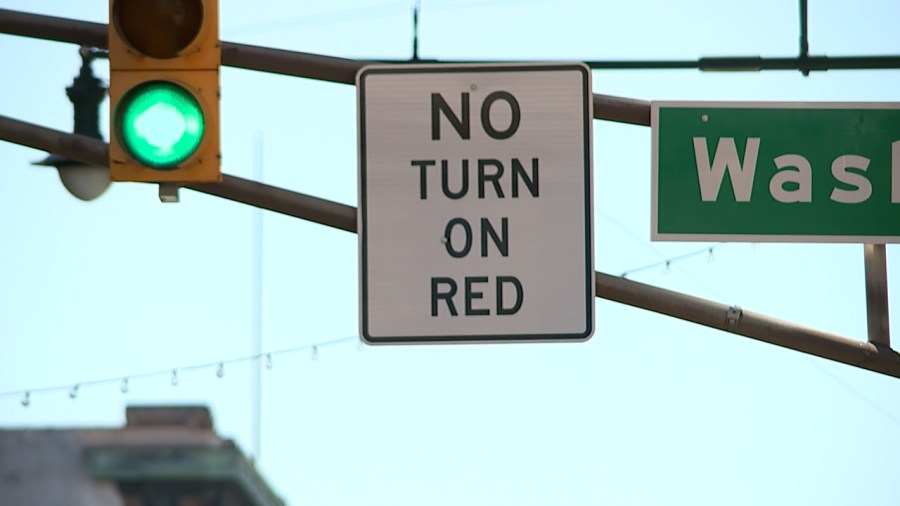Addressing dangerous downtown Indy intersections

INDIANAPOLIS — Fatal vehicle crashes happen with alarming regularity in Indiana.
“In Indiana, in 2019, we had over 700 deaths of people on our roadways and this year we are on track for over 1,000,” said State Senator Andrea Hunley (D-Indianapolis).
Often, the people killed in Indianapolis crashes are pedestrians.
Consider this. Every two years, the DC-based organization Smart Growth America takes a nationwide look at pedestrian fatalities in crashes. The 2022 report found Indianapolis has a higher rate of pedestrians killed (1.93 per 100,000 residents) than San Francisco (1.61), New York (1.52) and Chicago (1.36).
The rise in America of crashes taking the lives of pedestrians has been going on for over a decade, said Steve Davis, the assistant vice president at Smart Growth America.
“They’ve almost doubled since 2009,” Davis said. “We think this is a real crisis and one the reasons we think it’s such a crisis is because it is preventable.”
Davis pointed out there are ways to design streets with features that provide greater protection for both pedestrians and bicyclists. However, he added that the real culprit is speed.
“It is the most important factor,” Davis said.
Davis specifically pointed to E. Washington Street as an example where speeding vehicles have placed people on foot in greater danger.
FOX59/CBS4 visited the street at its intersection with Emerson Avenue, which sits within a neighborhood of homes and small shops. We brought with us a radar gun to check vehicle speed on Washington Street, where the speed limit is 35 miles per hour.
In just 20 minutes on a Thursday morning, we found vehicles traveling 50, 63 and 66 miles per hour. We also saw plenty of pedestrians walking the sidewalks on either side of the street that are just feet from the street curb.
If you’re wondering where the most dangerous places are in Indianapolis for pedestrians, the city’s Department of Public Works has concluded that it is downtown intersections.
“You are twice as likely to be struck by a turning vehicle in the downtown area than you would be anywhere else in the city,” said Nathan Sheets, Indy DPW’s administrator for planning and compliance.
Sheets and his team combed through Indiana State Police data in an attempt to find the places where pedestrians were most likely to be hit or killed by vehicles. They found a whopping 77% of vehicle-pedestrian crashes happen in downtown Indy intersections.
To address that, this summer the City installed ‘No Turn on Red’ signs at 97 intersections, most of them in the downtown area. For a full list of where the signs were installed, click here.
“This by no means is going to solve all the crashes,” Sheets said.
However, Sheets said he believes that based on the data, eliminating turns at downtown traffic signal intersections will increase pedestrian safety.
The question is, how long with these signs stay up?
State Senator Aaron Freeman (R-Indianapolis) has opposed the signs since the idea was floated in April. He has repeatedly described the move as “stupid” and would only succeed in making vehicles driving downtown go unnecessarily slow.
Freeman also successfully pushed through an amendment on a transportation bill that would have blocked the ‘No Turn’ signs, but a technical ruling has allowed the Indy signs to stay up for now.
“I can assure you I will be back in the General Assembly, God willing, come Jan. 1,” Freeman promised. “And we’ll have a bill to deal with this.”
Freeman said the real solution is more traffic enforcement by local law enforcement, specifically the Indianapolis Metropolitan Police Department.
That may be asking the city police force to do more with less. IMPD is currently down 300 officers, forcing the agency to make some tough decisions on what gets police attention.
“Our motorcycle officers that are traditionally been the ones we’ve tasked with traffic enforcement are tasked with other things,” said IMPD Assistant Chief Christopher Bailey.
Events downtown and the visitors they draw often siphon off motorcycle cops and other officers for crowd and street control duties.
Traffic tickets in Marion County are also down sharply, showing a one-third drop from four years ago to now with 61,796 citations issued in 2019 compared to 42,489 in 2022.
Assistant Chief Bailey noted that traffic enforcement is not only handing out tickets, and that just pulling someone over to give an operator a warning can be effective in changing driving behavior.
However, Bailey added that addressing safety on city streets includes making sure drivers “worry that there’s gonna be red and blue lights in [their] rear-view mirror” if they break traffic laws.
State Senator Hunley, who said she often rides a bicycle to the Statehouse, noted that it may be time to consider automatic enforcement of laws through traffic cameras.
“That is the stop-light camera that can catch people who are speeding or flying through intersections,” Hunley said. “And if the sign says, ‘No Turn on Red,’ the people who turn on red can automatically be sent tickets. That automatic enforcement does help.”
The catch is that red-light and speed enforcement cameras are not legal in the State of Indiana, and the prospect of the Republican super-majority changing state law to allow Indianapolis to implement them does not appear likely.
That leaves Indianapolis with a short-handed police department, speeding motorists, ‘No Turn’ signs with an unclear future and the ongoing danger to pedestrians.

Comments are closed.